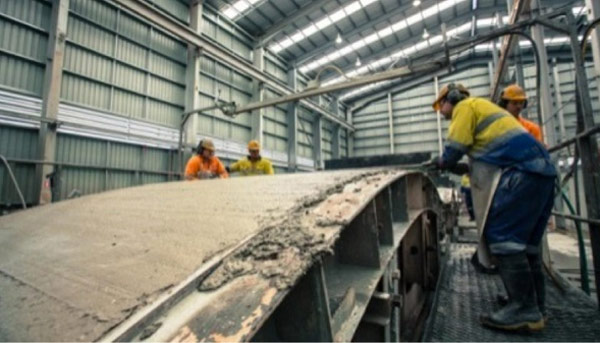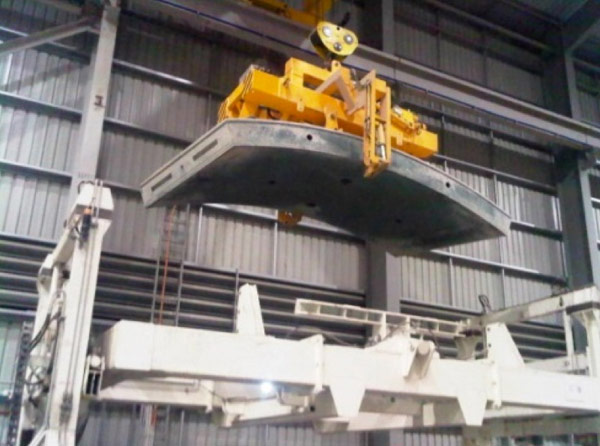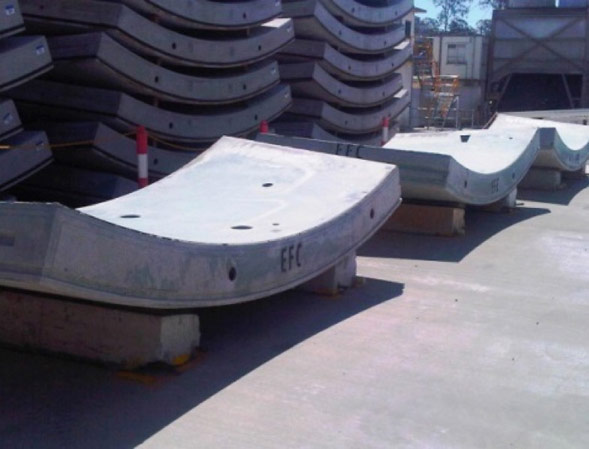TunnelTECH Geopolymer concrete for durable linings
Jan 2014
Tom Glasby, John Day and Michael Kemp, Wagners, Toowoomba, Australia
James Aldred, AECOM, Sydney, Australia
-
Earth Friendly Concrete (EFC) is a proprietary geopolymer concrete developed in Australia and used in a range of precast and in-situ applications. As a viable and sustainable alternative to Portland cement-based systems, Tom Glasby, Michael Kemp and James Aldred make the case that EFC provides a concrete with benefits that include: high resistance to sulfate attack, high resistance to acid attack, low heat of reaction, low shrinkage, and high early strength development. Mechanical, durability, and other properties indicate that EFC complies with the performance-based requirements of the Australian Concrete Structures code (AS 3600), which is in line with similar international standards.
- Geopolymer is a generic term coined by Joseph Davidovits[1] in the 1970s to describe the reaction of materials containing alumino silicate with concentrated alkaline solution to produce an inorganic polymer binder. Initial research began in the 1940s following construction of a range of projects using alkali activated slag cement concretes produced throughout Eastern Europe[2]. While there has been significant academic work carried out since then, full commercial exploitation of this technology has not occurred.
- An important improvement to the field of commercial geopolymers has been the development of a new admixture capable of providing the necessary workability and slump retention required for commercial concrete delivery and placement methods.
- Interest in geopolymer research in Australia has been motivated by the sustainability benefits of using a binder system composed almost entirely of recycled materials. A geopolymer binder has a reduction of about 80% in carbon emissions compared to Portland cement[3]. EFC has a geopolymer binder made from a combination of ground granulated blast furnace slag (GGBS) and flyash as its alumino silicate powder which is activated by the addition of chemicals either as powders or in solution under an ambient curing temperature.
- Over the past four years, Wagners, a company based in Queensland, Australia, has produced in excess of 6,000m3 of EFC covering a range of applications including structural precast elements, in-situ pavements, precast prestressed bridge beams, precast floor beams, and water tanks. Several of these projects have been completed for R&D purposes with monitoring instrumentation included and the testing of samples to capture the necessary engineering and materials data. As a result, a broad knowledge of the structural behaviour of this particular geopolymer concrete is now well established. Of particular interest has been the use of EFC in a set of trial precast concrete segments for the Legacy Way Highway Tunnel in Brisbane that is currently in construction.
- Geopolymer research suggests improved durability properties, however the term geopolymer refers to a very wide range of binder types depending on the alumina silicate source powder and the activators used.
- To assess EFC, Wagners commissioned RMIT University in Melbourne to undertake a durability study which commenced in March 2012. The study results demonstrate a significant improvement over Portland cement-based concrete in the important durability properties of acid resistance, sulfate resistance, and chloride-ion resistance.
-
EFC trial projects
The more than 6,000m3 of EFC produced by Wagners over the past four years is distinct from labcrete studies and demonstrates the commercial nature of this particular geopolymer concrete. - A number of slab-on-ground projects established the practical aspects of EFC, including workability, set time, pumpability, placement techniques, and curing techniques. Early trials indicated that placement of EFC in slabs on the ground was more difficult and labour intensive than traditional concrete. Higher cohesion or 'stickiness' coupled with a propensity for premature surface drying were early problems that were overcome by development in Germany of a proprietary purpose-designed admixture for EFC. Additionally, the chemical activators have been refined.
- EFC appears ideal for precast manufacture. It has a natural off-white appearance that is desired for architectural concrete; it provides a clean off-form surface with fewer blow holes; and accelerated curing can be achieved at lower temperatures than Portland cement concrete. Maximum efficiency is achieved by keeping EFC at an internal concrete temperature of 38°C.
-

Fig 1. Deflection beam test monitored using transducers
- In December 2010, two precast prestressed 50MPa grade EFC bridge beams were cast for an R&D study at the Wagners precast facility in Brisbane. Internal vibrating wire strain gauges were cast into the beams to allow monitoring of creep and shrinkage over a period of time. The prestress was transferred after three days. The girders were left unloaded for 100 days and monitored for hogging deflection under the internal prestress. The girders were loaded with W80 wheel load (eight tonnes) in accordance with the Australian bridge standard (AS 5100) and were continuously measured for deflections over the subsequent period, which is now three years. The hogging prior to load and deflection under sustained load were monitored using transducers (Fig 1). The structural behaviour in the girders was consistent with the compressive strength and modulus indicating no unusual deformation properties. Analysis of the strain data revealed very limited creep in the girder beyond 17 months.
- Construction of two water tanks of 10m diameter x 2.4m high in March 2011 was part of a study to assess the water resistant properties of EFC and investigate the autogenous healing behaviour of geopolymer concrete. One tank was built using a Grade 32MPa concrete with a maximum aggregate size of 10mm with blended cement consisting of 80% Portland cement and 20% flyash. The second used a Grade 32MPa EFC geopolymer concrete also with a 10mm maximum aggregate.
- Autogenous healing in Portland cement-based concrete is primarily due to the deposition of calcium hydroxide. There is no calcium hydroxide in EFC, however nominal leaking through cracks in the EFC tank did heal relatively rapidly, which is likely due to a gel swelling mechanism[4].
-
Engineering data
Many studies have been completed to produce a range of the engineering material properties of EFC geopolymer concrete that are used in the design of reinforced and prestressed concrete structures, including compressive strength, tensile strength, modulus of elasticity, stress-strain curve, poisons ratio, drying shrinkage, creep, and fire resistance[5].
- EFC can be produced in all typical commercial compressive strength grades. Extensive compressive test data is available for 32, 40 and 50MPa. Under an ambient temperature curing range of 20-35°C, EFC displays good early age strength development with 80% of the 28-day strength being achieved in seven days.
- In comparison to Portland cement-based concrete, for each strength grade, EFC has a distinct advantage in flexural tensile strength and drying shrinkage. EFC achieves approximately 30% higher flexural tensile strength than would be expected for a similar compressive strength grade of Portland cement-based concrete. On one project, grade 40 EFC achieved an average flexural tensile strength of 6.4MPa.
- Across all frequently tested EFC grades, the average 56-day drying shrinkage tested to AS 1012.13 is 350 microstrain. This is a significant reduction to typical Australian concretes made with similar sands and aggregates that have an average 56-day drying shrinkage of 650 microstrain.
- All tested engineering properties outlined above show that EFC can be designed using normal reinforced concrete design rules for meeting the same structural performance criteria. Increased flexural tensile strength and reduced drying shrinkage are two engineering properties worth noting as being significantly better than traditional concrete, leading to improvements in the structural and serviceability performance of many structure types.
-

Fig 2. Exposure to sodium sulfate solutions
-
Durability of EFC
The body of research literature on geopolymer concrete strongly suggests an increased resistance to a range of common degradation mechanisms that negatively affect Portland cement-based concrete. The chemistry of the geopolymer binder and the performance of the resulting concretes vary substantially. For this reason, it is important to match geopolymer research results with appropriately similar concretes. EFC contains both slag and flyash in its feedstock powder and is more aligned with an alkaline activated slag system that is ambient cured than to a flyash geopolymer binder cured at an elevated temperature. - Independent study on EFC undertaken by the RMIT University in Melbourne provides the following results.
-

Fig 3. Exposure to magnesium sulfate solutions
-
Sulfate resistance
For prisms immersed in sodium and magnesium sulfate solutions at 500, 5,000 and 50,000ppm, EFC geopolymer concrete with a binder content of 400kg/m3 had significantly reduced length change in both sulfate solutions when compared with a reference Portland cement concrete with 30% flyash, which would be considered to have reasonable sulfate resistance according to BRE Special Digest[6] (Figs 2 and 3). - These results compare favourably with Douglas et al[7] who found little changes in mechanical properties of sodium silicate activated slag concrete after 120 days of immersion in 5% sodium sulfate solutions, even smaller than the controlled specimens in lime saturated water or tap water for the same time period.
-
Acid resistance
Measured after immersion in different concentrations of sulfuric acid (Molarity - 0.005, 0.05 and 0.5) for nearly one year, there was virtually no change in mass for the EFC geopolymer specimens. There were mass changes for a reference Portland cement concrete with a comparable binder content (400kg/m3) with 30% flyash replacement and a water:cement ratio of 0.4 (Fig 4). EFC demonstrated excellent resistance to sulfuric acid attack.
-

Fig 4. Mass change after immersion in sulfuric acid solutions
- These results are supported by Shi[8] who found that alkali activated slag paste provides a better resistance to acid attack than Portland cement paste, using solutions of nitric acid and acetic acid with a pH of 3. The observed improvement was attributed to the difference in nature of hydration products between alkali activated slag and Portland cement.
-
Chloride corrosion resistance
Exposure trials on 600mm x 600mm x 200mm panels of EFC geopolymer concrete are being conducted at three maritime sites in Australia. The results of 90-day AASHTO T259 ponding tests indicate that with 400kg/m3of binder content, EFC showed virtually no chloride penetration from 0-50mm depth (less than 0.017%). McGrath and Hooton[9] reported that concretes with a water:cement ratio of 0.4 and 25% flyash or 8% silica fume replacement had a chloride concentration of 0.1% to a depth of 12.3mm and 7.7mm, respectively. - Testing to the ASTM C1202 standard for Electrical indication of concrete's ability to resist chloride ion penetration by Queensland TMR showed a value of 229 coulombs. This is classified as very low according to Table 1 in the Standard.
- Bernal et al[10] compared the ASTM C1202 results for alkali activated slag concretes and Portland cement concretes with three different binder contents and found that the slag geopolymer concretes had significantly lower coulomb values for all three binder contents. In Portland cement-based concrete, ground granulated blast furnace slag (GGBS) replacement has been widely used to reduce chloride penetration to achieve durable reinforced concrete in marine environments and where de-icing salts are used[11]. Roy et al[12] measured the effective chloride diffusion coefficient for pastes containing a range of GGBS percentages and included activated and non-activated systems. Their results demonstrate a clear trend of a decreasing diffusion rate with an increasing percentage slag for both non-activated and activated systems.
-
Carbonation
Carbonation, the mechanism of de-passivation of reinforcing steel embedded in concrete, in Portland cement concrete is the result of CO2 dissolving in water to form carbonic acid which reacts with Ca(OH)2 to form calcium carbonate reducing the pH in the cement matrix[13]. Carbonation in Portland cement-based concrete is usually accompanied with a shrinkage, which may produce cracking or surface crazing of concrete. - RMIT conducted accelerated carbonation testing on EFC with a binder content of 400kg/m3. The carbonation depth after 56 days of exposure was 12.6mm compared to 10.0mm for a 50MPa concrete containing Portland cement only and 13.2mm for a 40MPa concrete with 30% GGBS replacement. These data suggest that the rate of carbonation for this proprietary geopolymer should be similar to normal concrete in Australia, most of which would use blended cement.
-

Fig 5. EFC heat of reaction
-
Heat of reaction
EFC has a low heat of reaction. When the temperature rise in one-cubic-metre insulated blocks was compared with a reference concrete containing low heat cement with 65% GGBS and a cementitious content of 425kg/m3, the temperature rise for EFC was only 15°C compared to 37°C for the 65% GGBS replacement (Fig 5). -
EFC precast tunnel segments
EFC was delivered to the precast factory for the production of a complete tunnel ring of nine segments during the production of the segmental lining for the TBM-bored Legacy Way Highway Tunnel in Brisbane. A low-slump EFC mix was designed based on achieving the concrete performance specification and the handling and placement requirements of the precast factory, which uses an automated carousel system. Steel and polypropylene fibres were included in the mix as per the specification. The EFC tunnel segments were produced successfully and have been kept as a valuable demonstration model. De-moulding of the finished segments using the factory's automated handling system was undertaken as per normal concrete production after the low temperature chamber curing. The finished units displayed a smooth de-moulded finish and held the curved top surface profile very close to design.
- EFC would be suitable for factory-produced precast concrete tunnel segments in regions with high-sulphate ground waters, such as the Middle East. EFC is well suited to precast manufacture, attains high early strength, can be accelerated cured at 38°C and has a high resistance to sulfate attack. The high flexural tensile strength can also be used to refine the structural design of tunnel elements.
- Another possible tunnel-related application is sewer mains and drains where the high acid resistance of EFC precast concrete segments or jacking pipes would offer better protection to sulfuric acid attack than Portland cement-based concrete.
-
1. Davidovits, 1991. Geopolymers: Inorganic Polymeric New Materials. Journal of Thermal Analysis, 37, 1633-1656.
2. Roy, 1999. Alkali-activated cements-Opportunities and challenges. Cement and Concrete Research, 29, 249–254.
3. Concrete Institute of Australia, 2011. Recommended Practice: Geopolymer Concrete. Concrete Institute of
Australia. Sydney, Australia.
4. Ahn & Kishi, 2010. Crack Self-healing Behavior of Cementitious Composites Incorporating Various Mineral
Admixtures. Journal of Advanced Concrete Technology, 8(2), 171-186.
5. Aldred, 2013. Engineering Properties of a Proprietary Premixed Geopolymer Concrete. Proceedings of the
Concrete Institute of Australia Biennial Conference, Concrete 2013–Understanding Concrete. Gold Coast,
Australia.
6. BRE Special Digest 1, 2005. Concrete in aggressive ground.
7. Douglas, Bilodeau & Malhotra, 1992. Properties and Durability of Alkali-Activated Slag Concrete. ACI Materials
Journal, 89(5), 509-516.
8. Shi, 2003. Corrosion Resistance of Alkali-Activated Slag Cement. Advances in Cement Research, 15(2), 77-81.
9. McGrath & Hooton, 1999. Re-evaluation of the AASHTO T259 90-day salt ponding test. Cement and Concrete
Research, 29, 1239-1248.
10. Bernal et al, 2011. Effect of binder content on the performance of alkali-activated slag concretes. Cement and
Concrete Research, 41, 1–8.
11. Shi, Krivenko & Roy, 2006. Alkali-Activated Cements and Concretes. Taylor and Francis, Abingdon, UK.
12. Roy, Jiang & Silsbee, 2000. Chloride Diffusion in Ordinary, Blended, and Alkali-Activated Cement Pastes and Its
Relation to Other properties.Cement and Concrete Research, 30(12), 1879-1884.
13. Neville, 1995. Properties of Concrete, 4th edition. Addison Wesley Longman Limited, Essex, UK.
More details available in the conference paper presented at the Arabian Tunnelling Conference held in Dubai, United Arab Emirates in December 2013.
-
Celebrating success at Legacy Way in Brisbane - TunnelTalk, December 2013
Final breakthrough for Brisbane traffic link - TunnelTalk, June 2013
|
|
|
|
|
Add your comment
- Thank you for taking the time to share your thoughts and comments. You share in the wider tunnelling community, so please keep your comments smart and civil. Don't attack other readers personally, and keep your language professional.








